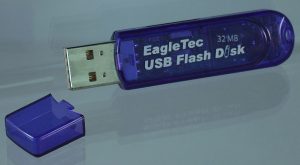History (2000): USB Flash Drive
Introduced by Trek Technology and IBM/M-Systems
This is a Press Release edited by StorageNewsletter.com on October 19, 2018 at 2:19 pmThis article was published by the Museum of Obsolete Media.
USB flash drive (2000-)

USB flash drives are a data storage format originally introduced commercially in 2000 by Trek Technology (under the name ThumbDrive) and by IBM (under the name DiskOnKey, developed by M-Systems).
The DiskOnKey offered storage of 8MB, more than five times the capacity of the then-common floppy disk.
As the name suggests, they consist of flash memory with, in most cases, a standard type-A USB connection.
USB flash drives are (usually) smaller and faster than floppy disks or CD-ROMs, and are more durable and reliable because they have no moving parts. Additionally, they are immune to magnetic interference (unlike floppy disks), and unharmed by surface scratches (unlike CD-ROMs).
USB flash drives draw power from the computer via the USB connection. Some devices combine the functionality of a digital audio player with USB flash storage; they require a battery only when used to play music.
Some USB flash drives may have novelty housing, or may be integrated into other items such as watches or pens.
Because they can hold so much data in an easily portable (and easily lost) format, from around 2004 versions of USB flash drives with hardware encryption became available alongside standard USB flash drives.













 Subscribe to our free daily newsletter
Subscribe to our free daily newsletter

